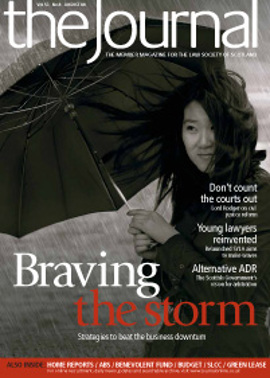Book reviews

Elaine E Sutherland
PUBLISHER: W GREEN
ISBN: 0 414 01630 9
PRICE: £150
Elaine Sutherland is a professor of law both in Scotland and in the USA, spending half the year in each, and she has long brought to her writings on Scots child and family law an awareness of the intense debates that so often rage in US academic circles, and courts. This text is a crowning achievement tapping into her unique talents.
Though a second edition (the first was published under another imprint in 1999), this can in many respects validly claim to be a brand new book. At 1,385 pages, it is almost double the size of the first edition, an increase caused largely by the fact that there are whole branches of the subject (civil partnership, gender recognition, human rights) that have either been created or come to full fruition since 1999 and which receive full and enlightening treatment here.
Eschewing a dry doctrinal exposition of Scots law (though the answers to most practical questions that might arise in Scotland will be found within these pages), her aim is to contextualise the law not only in terms of Scottish society but within socio-legal debates across the developed world. And it is here that her experience as a writer and teacher on American law proves invaluable, for child and family law is recognised there as being a subject of the highest political as well as legal and social importance, with the result that the literature is vast, contentious and reflecting of a far broader spectrum of opinion than we are used to in Europe.
There are in the US kulturkämpfen concerning, for example, the child before birth, same-sex relationships, child custody disputes, no-fault divorce, alimony, palimony, and probably petimony. Professor Sutherland taps into these debates in seeking to explain what the domestic rules of Scots law are, or should be, trying to achieve. A good example is her discussion of that crucial topic, financial provision on divorce. Now, practitioners in Scotland already have at their disposal a variety of existing commentaries on the 1985 Act. But what Professor Sutherland offers is a detailed exposition of the working of the Act in the context of what its aims are, what they could have been, and what they might yet become. She provides new arguments which have been tried elsewhere and which might well prove successful here.
Refreshingly, Professor Sutherland does not hesitate to nail her colours to the mast in relation to many of the major social debates covered in this book. Not for her the dull tendency of so many academic writers to claim a disinterest, or a need to strike a (sometimes spurious) balance between different political approaches. Professor Sutherland does give space to views with which she clearly disagrees, but she is always open in her disagreement, and tells us why.
This is most apparent in the extended sections of the book on same-sex relationships, in many respects the Great Debate in early 21st century family law. But here again she does not limit the discussion to the frankly sleep-inducing “marriage debate”: she widens her scope out to a variety of non-traditional family forms, including “living together apart” and “polyamory”, exploring what, if any, legal consequences might arise from people choosing to live their intimate lives in these ways. She makes no moral judgments, but plenty intellectual ones.
Not all of her conclusions, or ways of seeing things, would I agree with: I was uncomfortable, for example, with civil partnership being classed throughout as a form of “marriage-lite”, for I do not take the view that civil partnership as designed in the UK is any lighter relationship than the marital relationship. And I fear that the language of “marriage-lite” implies that marriage is the goal to be achieved, or the solution to all our worries. Professor Sutherland certainly does not see marriage in this way, but her language could be misconstrued as giving support to marriage as the only ideal worth aiming for.
This book is a remarkable achievement, one of which the author, and her employers in both Stirling and Portland, Oregon, should be justly proud. The book will be of very high value to Scottish practitioners and to law- and policy-makers. And it will be absolutely indispensable for all teachers of Scottish family law who wish to encourage their students to think about what our rules are, why we have them, where they came from, and what we might do differently.
Kenneth McK Norrie, University of Strathclyde
In this issue
- Where have we come from, where to next?
- Shifting sands
- A rank bad rule
- Braving the storm
- Civil justice: where next?
- Title Conditions Act: new registration procedures
- Young lawyers reborn
- Shining some more light...
- Power to the tribunal?
- Piece by piece
- The poor in our midst
- The Society's future role in complaints handling
- Appreciation: Lord Johnston
- Professional Practice Committee
- Facing the lean years
- It's a web 2.0 world
- Questions, questions
- Bare necessities
- Coming on the blind side
- Relocation, relocation
- Worse than the disease?
- Sleeping bounty
- Scottish Solicitors' Discipline Tribunal
- Website reviews
- Book reviews
- Industry standard
- Meet the committee
- What's in a motto?
- Leasing by example
- Good call?
- Home reports - the practice questions






